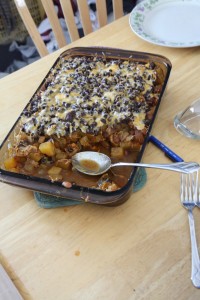I outlined my basic observation of differences here.
Another angle is that by doing things differently we begin to measure personal success in terms of success of the model we employ.
For example some parents (usually of only one child), directly attribute their child’s good behavior to their exceptional parenting skills.
This could be accurate, or it could be self-delusion. I tend to take their gushing advice with a grain of salt, wary of such a small sample size.
Just yesterday I was talking with another mom about homeschooling and we were comparing methods (not competing, just finding out. She’s literature-based; I do half our subjects with workbooks and the other half orally). I felt a warm, cozy comfort at our easy conversation, how we both tied our choices to our personalities and lifestyles, rather than the inherint *rightness* of the method itself.
I said so to her, saying how thankful I am to have several years “this way” behind me now, so I can compare a track long-enough to let me see both when and how my method really works and when it doesn’t. But how, over all, it averages out as effective.
My biggest discomfort in these “differences” interactions (whether it’s about parenting or schooling) is when someone attributes to the method what could just as easily be individual variation. For “failures” or “successes.”
Natasha was reading by age five. Melody, in the same environment, was still slogging through her phonics workbook at age six. Some people asked if we were doing the right thing. If we were using the right curriculum. And I did compare it to some other options, but felt nothing offered more than what we were using already.
Now seven, and nearly finished with those questioned phonics workbooks, Melody has a *solid* foundation that she builds on every day. She has developed independent study skills, problem-solving skills (we’re still working on focus and speed, but we’ve got time), and I couldn’t be more pleased with the progress she’s made.
~ ~ ~
There is so much individual variation between children that I really think once you have something solid (by any objective standard you can measure), as long as it’s not actually making life more complicated (we had one of those, too), it’s a matter of persevering.
Elisha has begun the same series of workbooks– despite my intent to hold him back one more year– and I can already see that he, like Melody a year ago, isn’t quite clicking with it.
~ ~ ~
I haven’t decided if I’ll do an enforced hold until he’s older (my original plan) or keep working intensively with him. One of the reasons I love the 50% workbooks approach is that it allows me to work independently too.
The books we use are so gradually advancing that the kids can frequently “self teach,” which is really important to me. Not because I want to keep them out of my hair (they wouldn’t be homeschooled if that was important to me), but because I se my life as been one long string of self-teaching.
I consider it one of the most-valuable life skills they can learn, so I’m thankful to have found texts that reenforce this value of mine.
~ ~ ~
One of the reasons studying personality has been so important to me is how it allows me incorporate that understanding of equality into interactions where differences could start to look like mistakes. Like someone “getting it wrong.”
What I want to remember, what I want to extend grace over, is that correct can be a lot-broader of a path than I choose to walk myself.
